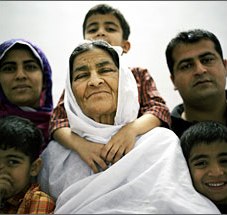Obesity Among Syrian Women Has Reached Epidemic Levels
January - February, 2008 | Volume 7, Issue 1

Photo by WHO/Chris de Bode
This Syrian woman has lost her leg
as a consequence of diabetes.
Obesity among Syrian women has reached epidemic levels affecting almost half of those studied, according to a recent paper published by a Fogarty-supported research team. The incidence rose with age, with an alarming 81 percent of Syrian women between the ages of 46 to 65 being categorized as obese. In comparison, obesity among U.S. women in the same age group is 24.4 percent.
Syria, a low-middle income country (LMIC), has witnessed rapid changes in lifestyle, and is showing a double disease burden where non-communicable diseases have emerged while infectious diseases continue unabated. According to a recent estimate from Aleppo, the country's second-largest city with a population of 2.5 million, about half of women aged 45 to 65 have hypertension. About 15 percent of older men and women have ischemic heart disease, and diabetes is also common.
The study was led by Dr. M. F. Fouad of the Center for Tobacco Studies in Aleppo. The team used data from the first Aleppo Household Survey, conducted in 2004 to provide a baseline of the main health problems affecting adults aged 18 to 65 in Aleppo. The team found:
- Obesity is related to the frequent consumption of certain food items, including coffee, olive oil, fruits and vegetables.
- There is a significant association between the prevalence of obesity among women with repeated pregnancies.
- Less-educated women were more likely to be obese than those with a higher level of education.
- Lack of physical activity has led to obesity in Syrian women with half of the women in the "low activity" category, as compared to one-fifth of the men.
- Male ex-smokers were more likely to be obese than current smokers.
- Married adults of both sexes were more likely to be obese than unmarried.
- The prevalence of obesity increased with age in both men and women.
The study shows that the prevalence of obesity among Syrian adults is high, especially in comparison with those from neighboring or industrialized countries. The soaring obesity rate among women is a matter of great concern and is likely to be rooted in Arab societal norms and gender roles, the paper suggests. Syrian women are often confined to their homes with little opportunity for recreation or sporting activities. The research team recommends further studies to obtain the full picture of the causes of obesity in Syria.
Prevalence of obesity and its associated factors in Aleppo, Syria. MF Fouad, S Rastam, KD Ward, and W Maziak. Prev Control. 2006 June; 2(2): 85–94. doi: 10.1016/j.precon.2006.09.001
To view Adobe PDF files,
download current, free accessible plug-ins from Adobe's website.